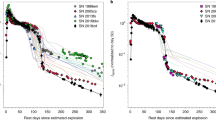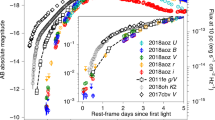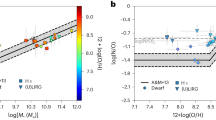Abstract
Red supergiants have been confirmed as the progenitor stars of the majority of hydrogen-rich type II supernovae1. However, while such stars are observed with masses >25 M⊙ (ref. 2), detections of >18 M⊙ progenitors remain elusive1. Red supergiants are also expected to form at all metallicities, but discoveries of explosions from low-metallicity progenitors are scarce. Here, we report observations of the type II supernova, SN 2015bs, for which we infer a progenitor metallicity of ≤0.1 Z⊙ from comparison to photospheric-phase spectral models3, and a zero-age main-sequence mass of 17–25 M⊙ through comparison to nebular-phase spectral models4,5. SN 2015bs displays a normal ‘plateau’ light-curve morphology, and typical spectral properties, implying a red supergiant progenitor. This is the first example of such a high-mass progenitor for a ‘normal’ type II supernova, suggesting a link between high-mass red supergiant explosions and low-metallicity progenitors.
This is a preview of subscription content, access via your institution
Access options
Access Nature and 54 other Nature Portfolio journals
Get Nature+, our best-value online-access subscription
$29.99 / 30 days
cancel any time
Subscribe to this journal
Receive 12 digital issues and online access to articles
$119.00 per year
only $9.92 per issue
Buy this article
- Purchase on Springer Link
- Instant access to full article PDF
Prices may be subject to local taxes which are calculated during checkout



Similar content being viewed by others
References
Smartt, S. J. Observational constraints on the progenitors of core-collapse supernovae: the case for missing high-mass stars. Pub. Astro. Soc. Aust. 32, 16–38 (2015).
Levesque, E. M. et al. The effective temperature scale of galactic red supergiants: cool, but not as cool as we thought. Astrophys. J. 628, 973–985 (2005).
Dessart, L. et al. Type II-Plateau supernova radiation: dependences on progenitor and explosion properties. Mon. Not. R. Astron. Soc. 433, 1745–1763 (2013).
Dessart, L. et al. Determining the main-sequence mass of Type II supernova progenitors. Mon. Not. R. Astron. Soc. 408, 827–840 (2010).
Jerkstrand, A. et al. The progenitor mass of the Type IIP supernova SN 2004et from late-time spectral modeling. Astron. Astrophys. 546, 28–49 (2012).
Li, W. et al. Nearby supernova rates from the Lick Observatory Supernova Search – II. The observed luminosity functions and fractions of supernovae in a complete sample. Mon. Not. R. Astron. Soc. 412, 1441–1472 (2011).
Falk, S. W. & Arnett, W. D. Radiation dynamics, envelope ejection, and supernova light curves. Astron. Astrophys. Suppl. S 33, 515–562 (1977).
Smartt, S. J. et al. The death of massive stars – I. Observational constraints on the progenitors of Type II-P supernovae. Mon. Not. R. Astron. Soc. 395, 1409–1437 (2009).
Woosley, S. E. et al. The evolution and explosion of massive stars. Rev. Mod. Phys. 74, 1015–1071 (2002).
Hirschi, R., Meynet, G. & Maeder, A. Stellar evolution with rotation. XII. Pre-supernova Models Astron. Astrophys. 425, 649–670 (2004).
Chieffi, A. & Limongi, M. Pre-supernova evolution of rotating solar metallicity stars in the mass range 13–120 M ⊙ and their explosive yields. Astrophys. J. 764, 21–57 (2013).
Jerkstrand, A. et al. The nebular spectra of SN 2012aw and constraints on stellar nucleosynthesis from oxygen emission lines. Mon. Not. R. Astron. Soc. 439, 3694–3703 (2014).
Jerkstrand, A. et al. Supersolar Ni/Fe production in the Type IIP SN 2012ec. Mon. Not. R. Astron. Soc. 448, 2482–2494 (2015).
Silverman, J. M. et al. After the fall: late-time spectroscopy of Type IIP supernovae. Mon. Not. R. Astron. Soc. 467, 369–411 (2017).
Walmswell, J. J. & Eldridge, J. J. Circumstellar dust as a solution to the red supergiant supernova progenitor problem. Mon. Not. R. Astron. Soc. 419, 2054–2062 (2012).
Davies, B. & Beasor, E. R. The initial masses of the red supergiant progenitors to Type II supernovae. Mon. Not. R. Astron. Soc. 474, 2116–2128 (2018).
Kochanek, C. S. Failed supernovae explain the compact remnant mass function. Astrophys. J. 785, 28–34 (2014).
Adams, S. M. et al. The search for failed supernovae with the Large Binocular Telescope: confirmation of a disappearing star. Mon. Not. R. Astron. Soc. 468, 4968–4981 (2017).
Arcavi, I. et al. Core-collapse supernovae from the Palomar Transient Factory: indications for a different population in dwarf galaxies. Astrophys. J. 721, 777–784 (2010).
Stoll, R. et al. Probing the low-redshift star formation rate as a function of metallicity through the local environments of Type II supernovae. Mon. Not. R. Astron. Soc. 773, 12–31 (2013).
Dessart, L. et al. Type II Plateau supernovae as metallicity probes of the Universe. Mon. Not. R. Astron. Soc. 440, 1856–1864 (2014).
Anderson, J. P. et al. Type II supernovae as probes of environment metallicity: observations of host H II regions. Astron. Astrophys. 589, 110–130 (2016).
Smartt, S. J. et al. PESSTO: survey description and products from the first data release by the Public ESO Spectroscopic Survey of Transient Objects. Astron. Astrophys. 579, 40–65 (2015).
Drake, A. J. et al. First results from the Catalina Real-Time Transient Survey. Astrophys. J. 696, 870–884 (2009).
Huber, M. et al. The Pan-STARRS Survey for Transients (PSST) – first announcement and public release. ATEL 7153, 1 (2015).
Taddia, F. et al. Metallicity from Type II supernovae from the (i)PTF. Astron. Astrophys. 587, 7–13 (2016).
Tremonti, C. A. et al. The origin of the mass-metallicity relation: insights from 53,000 star-forming galaxies in the Sloan Digital Sky Survey. Astrophys. J. 613, 898–913 (2004).
Woosley, S. E. & Weaver, T. A. The evolution and explosion of massive stars. II. Explosive hydrodynamics and nucleosynthesis. Astrophys. J. Suppl. S 101, 181 (1995).
Arnett, W. D. & Meakin, C. Toward realistic progenitors of core-collapse supernovae. Astrophys. J. 733, 78 (2011).
Fransson, C. & Chevalier, R. A. Late emission from SN 1987A. Astrophys. J. 322, L15–L20 (1987).
Maguire, K. et al. Constraining the physical properties of Type II-Plateau supernovae using nebular phase spectra. Mon. Not. R. Astron. Soc. 420, 3451–3468 (2012).
O’Connor, E. & Ott, C. D. Black hole formation in failing core-collapse supernovae. Astrophys. J. 730, 70–90 (2011).
Mueller, B. et al. New two-dimensional models of supernova explosions by the neutrino-heating mechanism: evidence for different instability regimes in collapsing stellar cores. Astrophys. J. 761, 72–84 (2012).
Bacon, R. et al. MUSE commissioning. Msngr 157, 13–16 (2014).
Buzzoni, B. et al. The ESO Faint Object Spectrograph and Camera (EFOSC). Msngr 38, 9–13 (1984).
Walton, N. et al. PESSTO spectroscopic classification of optical transients. ATEL 6516, 1 (2014).
Blondin, S. & Tonry, J. L. Determining the type, redshift, and age of a supernova spectrum. Astrophys. J. 666, 1024–1047 (2007).
Dessart, L. & Hillier, D.J. Non-LTE time-dependent spectroscopic modelling of Type II-plateau supernovae from the photospheric to the nebular phase: case study for 15 and 25 M ⊙ progenitor stars. Mon. Not. R. Astron. Soc. 410, 1739–1760 (2011).
Schlafly, E. F. & Finkbeiner, D. P. Measuring reddening with Sloan Digital Sky Survey stellar spectra and recalibrating SFD. Astrophys. J. 737, 103–126 (2011).
Fitzpatrick, E. L. Correcting for the effects of interstellar extinction. Pub. Astro. Soc. Aust. 111, 63–75 (1999).
Hamuy, M. et al. The Carnegie Supernova Project: The Low-Redshift Survey. Pub. Astro. Soc. Aust. 118, 2–20 (2006).
Landolt, A. U. UBVRI photometric standard stars in the magnitude range 11.5-16.0 around the celestial equator. Astron. J 104, 340–371 (1992).
Smith, J. et al. The u’g’r’i’z’ Standard-Star System. Astron. J. 123, 2121–2144 (2002).
Chambers, K. C. et al. The Pan-STARRS1 Surveys. Preprint at http://arXiv.org/abs/1612.05560 (2016).
Waters, C. Z. et al. Pan-STARRS pixel processing: detrending, warping, stacking. Preprint at http://arXiv.org/abs/1612.05245 (2016).
Magnier, E. A. et al. Pan-STARRS photometric and astrometric calibration. Preprint at http://arXiv.org/abs/1612.05242 (2016).
Smartt, S. J. et al. Pan-STARRS and PESSTO search for an optical counterpart to the LIGO gravitational-wave source GW150914. Mon. Not. R. Astron. Soc. 462, 4094–4116 (2016).
Tonry, J. L. et al. The Pan-STARRS1 photometric system. Astrophys. J. 750, 99–103 (2012).
Brown, T. M. et al. Las Cumbres Observatory Global Telescope Network. Pub. Astro. Soc. Aust. 125, 1031–1055 (2013).
Valenti, S. et al. The first month of evolution of the slow-rising Type IIP SN 2013ej in M74. Mon. Not. R. Astron. Soc. 438, L101–L105 (2014).
Weilbacher, P. M. et al. The MUSE data reduction pipeline: status after preliminary acceptance Europe. ASPC 485, 451 (2014).
Ott, T. QFitsView: FITS file viewer. ASCL 10019 (2012); http://adsabs.harvard.edu/abs/2012ascl.soft10019O
Yuan, F. et al. 450 days of Type II SN 2013ej in optical and near-infrared. Mon. Not. R. Astron. Soc. 461, 2003–2018 (2016).
Terreran, G. et al. The multi-faceted Type II-L supernova 2014G from pre-maximum to nebular phase. Mon. Not. R. Astron. Soc. 462, 137–157 (2016).
Hamuy, M. Observed and physical properties of core-collapse supernovae. Astrophys. J. 582, 905–914 (2003).
Phillips, M. M. et al. An optical spectrophotometric atlas of supernova 1987A in the LMC. II — CCD observations from day 198 to 805. Astron. J. 99, 1133–1145 (1990).
Arnett, D. Supernovae and Nucleosynthesis (Princeton Univ. Press, 1996).
Valenti, S. et al. The diversity of Type II supernova versus the similarity in their progenitors. Mon. Not. R. Astron. Soc. 459, 3939–3962 (2016).
Acknowledgements
T.K. and T.-W.C. acknowledge support through the Sofja Kovalevskaja Award provided to P. Schady from the Alexander von Humboldt Foundation of Germany. A.J. acknowledges funding by the European Union's Framework Programme for Research and Innovation Horizon 2020 under Marie Sklodowska-Curie grant agreement no. 702538. S.J.S. acknowledges funding from the European Research Council under the European Union’s Seventh Framework Programme (FP7/2007–2013)/ERC Grant agreement no. [291222] and Science and Technology Facilities Council (STFC) grants ST/I001123/1 and ST/L000709/1. M.D.S., C.C. and E.Y.H. gratefully acknowledge the generous support provided by the Danish Agency for Science and Technology and Innovation realized through a Sapere Aude Level 2 grant. M.D.S. acknowledges funding by a research grant (13261) from the VILLUM FONDEN. Support for S.G.-G. is provided by the Ministry of Economy, Development, and Tourism’s Millennium Science Initiative through grant IC120009 awarded to The Millennium Institute of Astrophysics (MAS), and CONICYT through FONDECYT grant 3140566. Support for C.A. is provided by the Ministry of Economy, Development, and Tourism’s Millennium Science Initiative through grant IC120009 awarded to The Millennium Institute of Astrophysics (MAS), and CONICYT through FONDECYT grant 3150463. M.F. acknowledges the support of a Royal Society–Science Foundation Ireland University Research Fellowship. K.M. acknowledges support from the STFC through an Ernest Rutherford Fellowship. M.S. acknowledges support from EU/FP7-ERC grant 615929. The work of the CSP-II has been supported by the National Science Foundation under grants AST0306969, AST0607438, AST1008343 and AST1613426. This work is based (in part) on observations collected at the European Organisation for Astronomical Research in the Southern Hemisphere, Chile as part of PESSTO (the Public ESO Spectroscopic Survey for Transient Objects) ESO program 188.D-3003, 191.D-0935. This work is based (in part) on observations collected at the European Organisation for Astronomical Research in the Southern Hemisphere under ESO programme 296.D-5003(A). This work was partly supported by the European Union FP7 programme through ERC grant number 320360. Pan-STARRS is supported by NASA grants NNX08AR22G, NNX14AM74G. PS1 surveys acknowledge the PS1SC: University of Hawaii, MPIA Heidelberg, MPE Garching, Johns Hopkins University, Durham University, University of Edinburgh, Queens University Belfast, Harvard-Smithsonian CfA, LCOGT, NCU Taiwan, STScI, University of Maryland, Eotvos Lorand University, Los Alamos National Laboratory, and NSF grant no. AST-1238877. A. Gal-Yam, M. Bersten, F. Förster, J. Hillier, F. Taddia and C. Fransson are thanked for useful discussions. This research has made use of: the NASA/IPAC Extragalactic Database (NED), which is operated by the Jet Propulsion Laboratory, California Institute of Technology, under contract with the National Aeronautics; iraf, which is distributed by the National Optical Astronomy Observatory, which is operated by the Association of Universities for Research in Astronomy (AURA) under cooperative agreement with the National Science Foundation; QfitsView; and the SDSS, funding for the SDSS and SDSS-II has been provided by the Alfred P. Sloan Foundation, the Participating Institutions, the National Science Foundation, the US Department of Energy, the National Aeronautics and Space Administration, the Japanese Monbukagakusho, the Max Planck Society and the Higher Education Funding Council for England. The SDSS Web Site is http://www.sdss.org/.
Author information
Authors and Affiliations
Contributions
J.P.A. performed the analysis and wrote the manuscript. L.D. helped write the manuscript and provided comments on the physical interpretation. C.P.G. provided specific measurements of pEWs of spectral lines and was part of the overall project to obtain these data. T.K. reduced the MUSE dataset. L.G. helped obtain the MUSE dataset. A.J. provided comments on the physical interpretation of the nebular spectral comparisons. S.J.S. is principal investigator of the PESSTO project, through which spectra were obtained. C.C. provided calibrated photometry from the CSP-II. M.P.P. is principal investigator of the CSP that provided photometry. N.M., M.S., E.Y.H, S.C. and C.G. are co-investigators on the CSP, which provided photometric data. S.G.-G. analysed the light-curve data of SN 2015bs. C.A., T.W.-C., M.F., C.I., E.K., S.M., K.M., J.S., M.S., D.R.Y. and S.V. were part of the PESSTO project, through which spectra were obtained. K.C.C., H.F., M.H., E.M. and T.B.L. provided photometry through the Pan-STARRS project. G.H. provided a spectrum from LCO.
Corresponding author
Ethics declarations
Competing interests
The authors declare no competing interests.
Additional information
Publisher’s note: Springer Nature remains neutral with regard to jurisdictional claims inpublished maps and institutional affiliations.
Supplementary information
Supplementary Information
Supplementary Figures 1–12, Supplementary Tables 1–5.
Rights and permissions
About this article
Cite this article
Anderson, J.P., Dessart, L., Gutiérrez, C.P. et al. The lowest-metallicity type II supernova from the highest-mass red supergiant progenitor. Nat Astron 2, 574–579 (2018). https://doi.org/10.1038/s41550-018-0458-4
Received:
Accepted:
Published:
Issue Date:
DOI: https://doi.org/10.1038/s41550-018-0458-4
This article is cited by
-
A hybrid envelope-stripping mechanism for massive stars from supernova nebular spectroscopy
Nature Astronomy (2019)



